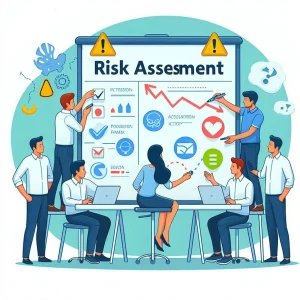In the realm of internal auditing, the concept of risk data governance has emerged as a critical framework that ensures the integrity and reliability of data used in risk management processes. Risk data governance refers to the set of processes, rules, and standards that organizations implement to maintain high-quality data throughout its lifecycle. This governance framework is essential for internal auditors, as it directly impacts their ability to assess risks accurately and make informed decisions.
Definition of Risk Data Governance
Risk data governance encompasses the practices and policies that organizations adopt to manage their data effectively, ensuring that it is accurate, consistent, and compliant with relevant regulations. It involves identifying risks associated with data management, assessing those risks, and implementing measures to mitigate them. This structured approach not only safeguards data but also enhances its quality, which is vital for effective risk analysis and reporting [3][4][9].
Relevance to Internal Auditors
For internal auditors, risk data governance is particularly relevant as it serves as the foundation for their audit processes. By ensuring that data is of high quality, internal auditors can rely on accurate information when evaluating an organization’s risk exposure and compliance with regulations. This reliance on quality data is crucial, as poor data quality can lead to misguided conclusions and ineffective risk management strategies [10][14]. Furthermore, a robust risk data governance framework helps auditors identify potential areas of concern, thereby facilitating proactive risk management and enhancing overall organizational performance [11][15].
Importance of Data Quality in Risk Management
Data quality is paramount in the context of risk management. High-quality data enables organizations to conduct thorough risk assessments, make sound decisions, and comply with regulatory requirements. Inaccurate or inconsistent data can obscure potential risks and lead to significant financial and reputational damage. Therefore, internal auditors must prioritize data quality as a key component of their risk management efforts. By focusing on data accuracy, consistency, and compliance, auditors can ensure that their findings and recommendations are based on reliable information, ultimately supporting the organization’s strategic objectives [5][7][10].
Risk data governance is an essential aspect of internal auditing that emphasizes the importance of data quality in effective risk management. By understanding and implementing robust data governance practices, internal auditors can enhance their ability to identify and mitigate risks, thereby contributing to the overall success of their organizations.
Understanding Risk Data Governance
Risk data governance is a critical aspect of internal audit processes, particularly in ensuring that organizations manage their data effectively to support risk management and decision-making. This section will explore the essential components of risk data governance, the roles and responsibilities involved, and its relationship with overall organizational risk management.
Components of Risk Data Governance
Effective risk data governance is built upon several key components:
- Policies: These are formal guidelines that dictate how data should be managed, protected, and utilized within the organization. Policies ensure that data governance aligns with regulatory requirements and organizational objectives, thereby enhancing data quality and security [10].
- Procedures: These are the specific steps and processes that must be followed to implement the policies. Procedures help in standardizing data handling practices, ensuring consistency, and minimizing errors that could compromise data quality [12].
- Frameworks: A robust data governance framework provides the structure necessary for managing data assets. It outlines the roles, responsibilities, and processes involved in data governance, ensuring that data is handled appropriately throughout its lifecycle [13].
Roles and Responsibilities within Risk Data Governance
Understanding the roles and responsibilities within risk data governance is crucial for effective implementation:
- Chief Compliance Officer: Responsible for ensuring that the organization adheres to relevant laws and regulations regarding data management. This role is vital in maintaining data quality and compliance [11].
- Data Owners: These individuals are accountable for the data within their domain. They ensure that data is accurate, secure, and used appropriately, which directly impacts the quality of risk data [13].
- Internal Auditors: They play a unique role in assessing the effectiveness of risk data governance. By evaluating the adequacy of data management practices, internal auditors help identify potential risks and ensure that data quality is maintained [2][4].
The Relationship Between Risk Data Governance and Overall Organizational Risk Management
Risk data governance is intrinsically linked to an organization’s overall risk management strategy. Here’s how:
- Data Quality and Decision-Making: High-quality data is essential for informed decision-making. Effective risk data governance ensures that data is accurate, reliable, and timely, which enhances the organization’s ability to identify and respond to risks [10][11].
- Risk Identification and Assessment: A well-structured risk data governance framework aids in identifying both internal and external risks. By ensuring that data is properly managed, organizations can better assess potential threats and evaluate their impact on business objectives [5][6].
- Compliance and Security: Risk data governance helps organizations comply with regulatory requirements and protect sensitive data. This not only mitigates risks associated with data breaches but also supports the organization’s reputation and trustworthiness [12].
Understanding risk data governance is essential for internal auditors and data analysts. By focusing on data quality and establishing clear policies, procedures, and frameworks, organizations can enhance their risk management capabilities and make more informed decisions.
The Role of Data Quality in Risk Management
In the realm of internal auditing, the significance of data quality cannot be overstated, particularly when it comes to risk data governance. High-quality data serves as the foundation for effective risk management and informed decision-making. Below, we explore the definition of data quality, its dimensions, and the implications of data quality on risk management processes.
Definition of Data Quality and Its Dimensions
Data quality refers to the reliability, accuracy, and completeness of data for its intended purpose. It encompasses several critical dimensions, including:
- Accuracy: Data must correctly reflect real-world values. Inaccurate data can lead to erroneous conclusions and decisions.
- Completeness: All necessary data should be present. Missing data can create gaps in risk assessments, leading to unaddressed vulnerabilities.
- Consistency: Data should be uniform across different datasets and systems. Inconsistent data can confuse stakeholders and undermine trust in the information being presented.
- Timeliness: Data must be available when needed. Delayed data can hinder timely decision-making, especially in fast-paced environments where risks can evolve rapidly.
These dimensions collectively ensure that the data used in risk assessments is reliable and trustworthy, which is essential for effective governance and management.
Examples of Poor Data Quality Leading to Misguided Risk Assessments
Poor data quality can have dire consequences for risk management. For instance:
- Inaccurate Risk Profiles: If an organization relies on outdated or incorrect data to assess risks, it may misidentify high-risk areas, leading to inadequate resource allocation and increased exposure to threats.
- Incomplete Risk Assessments: Missing data points can result in a failure to recognize potential risks. For example, if an internal auditor overlooks critical financial data, they may underestimate the financial risks associated with a project.
- Inconsistent Reporting: When different departments use varying definitions or formats for data, it can lead to conflicting risk assessments. This inconsistency can create confusion and hinder effective communication among stakeholders.
These examples illustrate how poor data quality can misguide risk assessments, ultimately compromising an organization’s ability to manage risks effectively.
The Impact of High-Quality Data on Decision-Making and Risk Mitigation Strategies
Conversely, high-quality data significantly enhances decision-making and risk mitigation strategies. The benefits include:
- Informed Decision-Making: Accurate and complete data allows internal auditors and data analysts to make well-informed decisions based on reliable insights. This leads to more effective risk management strategies that align with organizational goals.
- Proactive Risk Mitigation: With high-quality data, organizations can identify potential risks early and implement proactive measures to mitigate them. This foresight can prevent costly incidents and enhance overall resilience.
- Enhanced Stakeholder Confidence: When data quality is prioritized, stakeholders are more likely to trust the findings and recommendations of internal auditors. This trust fosters a culture of transparency and accountability, which is vital for effective governance.
The role of data quality in risk data governance is paramount for internal auditors. By ensuring that data is accurate, complete, consistent, and timely, organizations can enhance their risk management processes, leading to better decision-making and more effective risk mitigation strategies. Prioritizing data quality not only safeguards against potential risks but also positions organizations for success in an increasingly data-driven landscape.
Challenges in Ensuring Data Quality
Maintaining data quality is a critical aspect of risk data governance for internal auditors, as it directly influences effective risk management and decision-making. However, several challenges can hinder the ability of internal auditors to ensure high data quality. Here are some of the most common obstacles:
- Data Silos and Fragmented Information Systems: Internal auditors often encounter issues related to data silos, where information is stored in isolated systems that do not communicate with one another. This fragmentation can lead to inconsistencies and duplication of data, making it difficult to obtain a comprehensive view of risk across the organization. The lack of integration among various data sources complicates the auditing process and can result in inaccurate assessments of risk [3][11].
- Inconsistent Data Entry Practices Across Departments: Different departments may have varying standards and practices for data entry, leading to discrepancies in the data collected. This inconsistency can undermine the reliability of the data used in risk assessments and decision-making processes. When data is entered differently across departments, it becomes challenging to ensure that the information is accurate, complete, and relevant, which are essential qualities for effective risk management [4][15].
- Evolving Regulatory Requirements and Their Impact on Data Management: The landscape of regulatory requirements is constantly changing, which can create additional challenges for internal auditors. As regulations evolve, organizations must adapt their data management practices to remain compliant. This can lead to increased complexity in data governance, as auditors must ensure that data quality meets not only internal standards but also external regulatory expectations. Failure to comply with these requirements can result in significant risks for the organization, including legal penalties and reputational damage [2][10].
Internal auditors face significant challenges in ensuring data quality due to data silos, inconsistent data entry practices, and evolving regulatory requirements. Addressing these challenges is essential for effective risk data governance and for supporting informed decision-making within the organization.
Best Practices for Enhancing Data Quality in Risk Data Governance
In the realm of internal audit, the significance of data quality cannot be overstated, particularly when it comes to risk data governance. High-quality data is essential for effective risk management and informed decision-making. Here are some actionable strategies that internal auditors can implement to enhance data quality within their organizations:
- Establish a Data Governance Framework: A robust data governance framework is foundational for ensuring data quality. This framework should clearly define roles and responsibilities for data stewardship, ensuring accountability across the organization. By establishing who is responsible for data management, organizations can minimize lapses in data controls and processes, which are critical for validating data quality and completeness [1][10].
- Implement Regular Data Quality Assessments and Audits: Conducting regular assessments and audits of data quality is vital for identifying and addressing potential issues. Internal auditors should develop and track key metrics that assess data quality, including accuracy, completeness, and consistency. These metrics can help in pinpointing areas that require improvement and ensuring that data governance policies are effectively enforced [9][15]. Regular audits also foster a culture of continuous improvement, encouraging feedback from data users to enhance data quality over time [13].
- Utilize Technology and Tools for Data Cleansing and Validation: Leveraging technology is crucial for maintaining high data quality. Internal auditors should implement tools for data profiling, cleansing, and validation. These tools can automate the process of identifying and correcting data errors, thereby improving the overall quality of data used in risk assessments and decision-making processes [8][10]. By integrating advanced data management technologies, organizations can enhance their ability to manage and protect their data assets effectively.
By focusing on these best practices, internal auditors can significantly improve data quality in risk data governance, leading to better risk management outcomes and more informed decision-making. The integration of a strong governance framework, regular assessments, and the use of technology will not only enhance data quality but also build trust and transparency in the data that drives business decisions.
Conclusion
In the realm of internal audit, the significance of data quality cannot be overstated, particularly in the context of risk data governance. High-quality data serves as the foundation for effective risk management and informed decision-making. Internal auditors rely on accurate, complete, and timely data to assess risks, evaluate controls, and provide valuable insights to stakeholders. When data quality is compromised, it can lead to misguided conclusions, ineffective risk assessments, and ultimately, poor organizational outcomes. Therefore, internal auditors must prioritize data quality as a critical component of their governance framework.
To foster a culture of data quality, data analysts and internal auditors are encouraged to take proactive steps. This includes implementing robust data governance practices that ensure data accuracy, consistency, and reliability throughout its lifecycle. By doing so, organizations can enhance their risk management capabilities and make more informed decisions that drive growth and compliance. Continuous training and awareness initiatives can further support this effort, emphasizing the broader impacts of data quality on business operations and risk management.
Looking ahead, the evolution of risk data governance in internal audit practices is poised to become increasingly sophisticated. As organizations continue to navigate complex regulatory environments and dynamic market conditions, the demand for high-quality data will only intensify. Internal auditors must adapt to these changes by embracing innovative technologies and methodologies that enhance data governance. By prioritizing data quality today, internal auditors can position themselves and their organizations for success in the future, ensuring that risk management practices are not only effective but also resilient in the face of emerging challenges.
Find out more about Shaun Stoltz https://www.shaunstoltz.com/about/
This post was written by an AI and reviewed/edited by a human.



